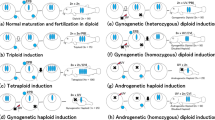Abstract
We have undertaken comparative studies of the number and phenotypes of erythrocytes in the peripheral blood of red crucian carp (RCC), blunt snout bream (BSB), and their hybrids, including triploids, tetraploids, and pentaploids. The results indicate that the mean nuclear volume of erythrocytes in peripheral blood increases regularly with increasing ploidy. Furthermore, many more mature erythrocytes have a dumbbell nucleus in the peripheral blood of polyploid hybrids compared with their diploid parents. With the increase in ploidy level, the percentage of such erythrocytes increases. The polyploid hybrids also have a large number of erythrocytes with abnormal shapes. For example, round and tear-shaped erythrocytes have been observed in the peripheral blood of polyploid hybrids. Since the erythrocytes in polyploid hybrids with their larger volume and lower specific surface area are unfavorable for the conveyance of oxygen, morphological variations of erythrocytes might improve defective blood circulation.


Similar content being viewed by others
References
Benfey T, Sutterlin A (1984) The haematology of triploid landlocked Atlantic salmon Salmo salar L. J Fish Biol 24:333–338
Benfey T, Sutterlin A, Thompson R (1984) Use of erythrocyte measurements to identify triploid salmonids. Can J Fish Aquat Sci 41:980–984
Boron A (1994) Use of erythrocyte measurements to detect natural triploids of spined loach Cobitis taenia (L.). Cytobios 78:197–202
Cassani JR, Maloney DR, Allaire HP, Kerby JH (1990) Problems associated with tetraploid induction and survival in grass carp, Ctenopharyngodon idella. Aquaculture 88:273–284
Espinosa E, Josa A, Gil L, Marti JI (2005) Triploidy in rainbow trout determined by computer assisted analysis. J Exp Zool 303A:1007–1012
Gregory TR (2001) The bigger the C-value, the larger the cell: genome size and red blood cell size in vertebrates. Blood Cells Mol Diseases 27:830–843
Harrell R, Van Heukelem W, Kerby J (1998) A comparison of triploid induction validation techniques. Prog Fish-Cult 60:221–226
Licht LE, Bogart JP (1987) Comparative size of epidermal cell nuclei from shed skin of diploid, triploid and tetraploid salamanders (Genus Ambystoma). Copeia 1987:284–290
Liu SJ, Liu Y, Zhou GJ, Luo C, Feng H, He XX, Yang H (2001) The formation of tetraploid stocks of red crucian carp × common carp hybrids as an effect of interspecific hybridization. Aquaculture 192:171–186
Liu SJ, Sun YD, Zhou GJ, Zhang XJ, Liu Y (2003) The ultra-microstructure of mature gonads and erythrocytes in alloteraploids (in Chinese). Prog Nat Sci 13:194–197
Liu Q, Wang YQ, Liu SJ, Guo XH, Luo KK, Zhang C, Liu Y (2004) Comparative studies on blood and blood cells in different ploidy fishes. Prog Nat Sci (in Chinese) 14:1111–1117
Liu SJ, Qin QB, **ao J, Lu WT, Shen JM, Li W, Liu JF, Duan W, Zhang C, Tao M, Zhao RR, Yan JP, Liu Y (2007) The formation of the polyploid hybrids from different subfamily fish crossings and its evolutionary significance. Genetics 176:1023–1034
Mallet J (2007) Hybrid speciation. Nature 446:279–283
Ohno S (1999) Gene duplication and the uniqueness of vertebrate genomes circa 1970–1999. Cell Dev Biol 10:517–522
Otto SP (2007) The evolutionary consequences of polyploidy. Cell 131:452–462
Pierrez J, Ronot X (1991) Use of diploid and triploid trout erythrocytes as internal standards in flow cytometry. Cytometry 12:275–278
Small S, Benfey T (1987) Cells size in triploid salmon. J Exp Zool 241:339–342
Thorgaard G, Rabinovitch P, Shen M, Gall G, Propp J, Utter F (1982) Triploid rainbow trout identified by flow cytometry. Aquaculture 29:305–309
Wang FJ (1990) Hemocytology and colour atlas, 2nd edn. Science and Technology, Tian**g
Wolters W, Chrisman C, Libey J (1982) Erythrocyte nuclear measurements of diploid and triploid channel catfish, Ictalurus punctatus (Rafinesque). J Fish Biol 20:253–258
Zhu LF, Gui JF, Liang SC, Jiang YG (1992) Observation on erythrocytes in artificial autotriploids and allotriploids of silver carp (Hypophthalmichthys molitrix) (in Chinese). Acta Hydrobiol Sin 16:84–86
Author information
Authors and Affiliations
Corresponding author
Additional information
This research was supported by the National Natural Science Fund for Distinguished Young Scholars (grant no. 30725028), the National Natural Science Foundation of China (grant nos. 30330480 and 30571444), National Basic Research Program (grant no. 2007CB109206), and Key Project of Hunan Province (grant no. 2006NK2008).
Rights and permissions
About this article
Cite this article
Lu, W., Liu, S., Long, Y. et al. Comparative study of erythrocytes of polyploid hybrids from various fish subfamily crossings. Cell Tissue Res 336, 159–163 (2009). https://doi.org/10.1007/s00441-009-0759-0
Received:
Accepted:
Published:
Issue Date:
DOI: https://doi.org/10.1007/s00441-009-0759-0




